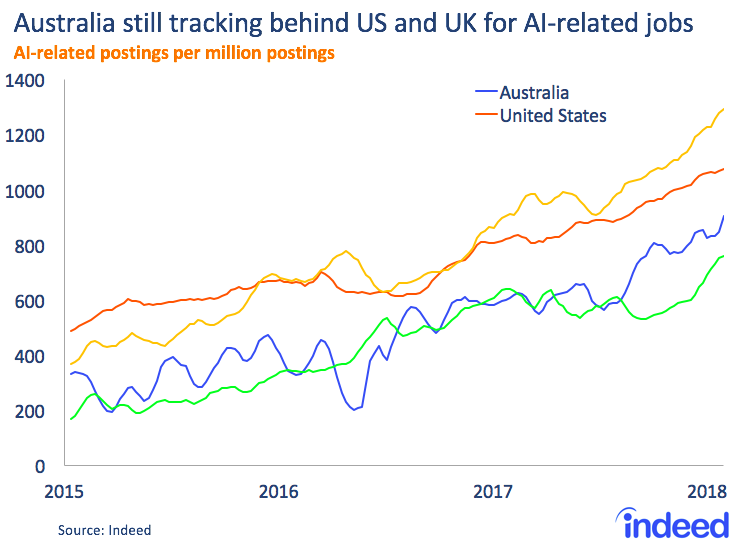Key points
- The number of AI-related jobs has doubled since 2015, with postings almost 50% higher in January 2018 than a year earlier.
- Search activity by job seekers for AI-related jobs has tripled over the same period.
- Around 25% of AI-related searches come from foreign job seekers.
Advances in technology and artificial intelligence (AI) have stoked fears of large-scale job losses. While it is certainly true that new technologies will destroy some jobs, they will also create new jobs and pave the way for cutting-edge industries. New AI technologies require highly skilled workers who can develop and maintain complex systems and applications. Using Indeed’s data on job postings and job search activity, we can observe the emergence of this sector in real-time.
Employer demand for AI-related jobs has doubled since 2015, with much of the increase occurring over the past 18-months. Luckily the interest is mutual, with job seeker interest in AI-related jobs three times higher today than it was in 2015.
To assess changes in the demand for AI-related work, we utilised Indeed job posting data to determine the job titles that most often referred to ‘artificial intelligence’ and ‘machine learning’ in their job descriptions.
Employer demand for AI skills has soared
Although the number of jobs in AI remain relatively small – highlighted by the week-to-week volatility in the number of job postings – the trend is unmistakable: the sector is getting bigger by the year. In 2017, the number of AI-related job postings, as a share of all job postings, was twice as high as it was during 2015, with most of that increase occurring in the past 18-months.
The number of AI-related job postings is tracking almost 50% higher in January 2018 than a year earlier. The top job titles are typically data scientists, of the senior and junior variety. The role of data scientists is much broader than simply creating AI but they play a pivotal role in creating the algorithms that teach machines how to use and interpret data. Everyday we are dealing with the end result of their work, whether it be via recommendations online, what we see on social media, or even the news that we consume.

The demand for AI skills in Australia appears to be tracking a year behind countries such as the United States and United Kingdom. That is, in January 2018 the number of AI-related jobs, per million postings, in Australia is roughly equal to the US or UK market a year ago. However, the vast increase in the number of AI-related job opportunities suggests that the Australian market is playing catch-up.

The results are encouraging given Australia’s mixed reception to AI technologies, particularly among the corporate sector. An Infosys report, released early last year and covering seven countries, including the US, UK and China, found that Australia was the country where businesses were least likely to have plans to implement AI-related technologies.
Increasing job seeker interest in AI-related jobs
In 2017, search activity in AI-related jobs, per million searches, tripled compared with 2015. This broadly matches the increase in AI-related job opportunities that has occurred over the same period. The AI sector is clearly in a developmental phase, growing by the day, and job seekers are only too happy to get in on the ground floor.

Around 25% of searches on AI-related jobs come from overseas. The changing nature of technology within the AI sector means that fast-changing skill needs may make the pool of potential workers smaller. For this very reason, Australian employers may look to overseas job seekers to expand that pool.
What is clear from the data, however, is that we are witnessing the emergence of an industry that is changing rapidly. Demand for AI-related skills will only continue to grow as the technology matures and becomes a central part of business operations. And the jobs created will continue to broaden, creating new opportunities for highly-skilled job seekers.
Methodology
For this research we classify AI-related jobs as job titles in which a substantial share of job posting descriptions include the terms ‘artificial intelligence’ and ‘machine learning’. The job posting trends reflect the change in volume of these specific job titles, which in Australia were ‘data scientist’, ‘machine learning engineer’, ‘algorithm engineer’, ‘predictive modeler’, ‘senior research engineer’. Data scientist was a large share of the AI job postings. To focus on job seeker interest in these AI-related jobs, we measure volume of job searches which contain any variant of those aforementioned AI-related job titles. All measures of job postings and job searches over time are calculated as a share of total job postings and job searches, respectively, on the site to account for changes in site activity over time. This research follows up on Indeed’s work featured in the recent AI Index report, a project developed by Stanford University.
